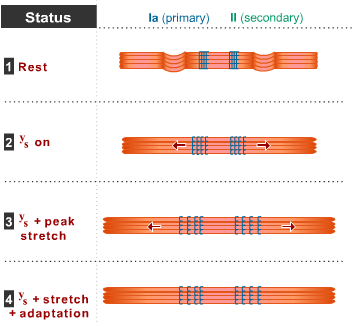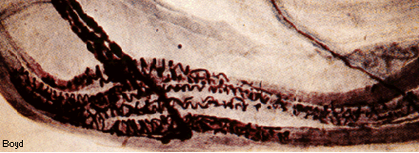At rest conditions:
- Chain fibres are often kinked in the absence of fusimotor stimulation or external stretch.
Static fusimotor stimulation:
- this causes both primary and secondary endings to be stretched and increase their discharge.
Stretching the chain fibres:
- overall this results in transmission of stretch to the primaries and, more so, to the secondaries which increase their discharge much more.
- When stretch is maintained there is no further mechanical change, however there is a reduction in afferent discharge due to electrical adaptation.
- Chain fibres bias the discharge of primary and secondary endings, disrupt length sensitivity of the primaries and ENHANCING length sensitivity of secondaries.
Click on the Primary & Secondary Ending tab above to continue.
Primary ending (group Ia) and secondary ending (group II) afferent discharge frequency during stretch alone (blue lines) and during stretch superimposed on tonic static gamma fusimotor stimulation (red lines) at 75Hz.
This shows graphically the effects of stretch alone (blue line) and stretch with simultaneous fusimotor stimulation (red line) in the standard test format for investigating spindle afferent ending responses.
The Y-axis represents the instantaneous firing frequency of the afferent neuron, with a scale from 0 to 100 impulses per sec. The Ia neuron responses are on the left, the group II neuron responses on the right. The ‘length’ trace shows when the stretch was applied; up = stretch. The fusimotor neuron in this case is the gamma dynamic (γd) type and the red dotted line shows the period when it was turned on.
Taking the primary ending as an example:
- initially there is only a low firing rate from this afferent ending
- stretch alone produces an instantaneous rise in firing rate to about 50/s and then rises further to about 60/s during the ramp phase of the stretch.
- At the start of the ‘hold’ phase of the stretch there is an initial fall to about 40/s, but then firing is well maintained right through to the end of the ‘hold’ phase starts the firing rate jumps up again, but then falls back to about 40/s during the ‘hold’ phase.
- As soon as the rlease phase starts firing drops to 0, only recovering to the initial low rate after the release phase has terminated
- stimulating the γd alone provokes a large rise in the firing rate to about 80/s
- combining γd stimulation with the ramp stretch provokes a further small rise in firing to about 90/s during the ramp phase of the stretch. The firing rate falls back to about 80/s once the ramp phase stops, and continues at this rate throughout not only the hold but also the release phases of the stretch, and stops only when the γd stimulation stops.
Select another item from the menu on left to continue.



